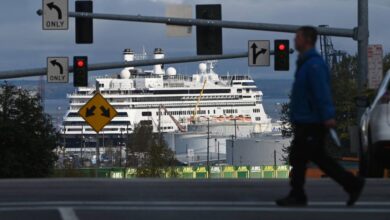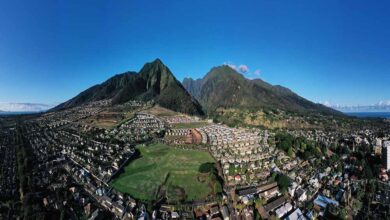
Americas Front Door A Historical Journey
America s front door – America’s front door sets the stage for this enthralling narrative, offering readers a glimpse into a story that is rich in detail and brimming with originality from the outset. From its historical evolution to its geographic impact, cultural significance, economic implications, and modern challenges, this exploration delves into the multifaceted nature of this symbolic gateway.
This journey through time examines how America’s “front door” – its ports, borders, and entry points – has shaped the nation’s identity, from its earliest days to the present. We’ll uncover the intricate interplay of history, geography, culture, and economics in molding this crucial aspect of American society.
Historical Significance
America’s “front door,” a multifaceted concept encompassing ports, border crossings, and immigration policies, has evolved dramatically throughout its history. From the earliest colonial settlements to the modern era, the methods and criteria for entry have mirrored the nation’s shifting geopolitical landscape and internal priorities. This evolution reveals a complex interplay between national identity, economic needs, and global events.The character of America’s entry points has been shaped by a constant tension between welcoming immigrants and controlling borders.
This dynamic has influenced the nation’s social fabric, economic growth, and cultural diversity. Policies and practices surrounding immigration have played a crucial role in defining the “front door,” impacting everything from the types of people allowed to enter to the experiences they faced.
Early Colonial Era (1600s-1776)
The initial “front doors” were primarily seaports, such as Boston, New York, and Philadelphia. These ports facilitated the arrival of colonists from Europe, primarily from England, Scotland, Ireland, and other parts of the British Isles. The early colonies had limited immigration policies, focusing more on attracting settlers to populate the land. The primary motivation was economic expansion and religious freedom, and the “front door” reflected this focus.
These early years established patterns of trade and migration that would continue to shape American society.
The 19th Century: A Period of Mass Migration
The 19th century saw a significant increase in immigration, primarily from Europe. The expansion of industrialization created a demand for labor, attracting millions of immigrants. New ports, like Ellis Island in New York, became major entry points, processing millions of immigrants. The “front door” shifted from a focus on simple settlement to one that also considered labor needs.
The 20th Century: Shifting Policies and Global Conflicts
The 20th century brought significant changes to immigration policies, shaped by both domestic and global events. The two World Wars, the Cold War, and the rise of global political tensions all impacted the “front door.” Immigration policies became more restrictive, reflecting concerns about national security and cultural preservation. The “front door” also had to contend with new waves of immigration from Asia, Latin America, and other parts of the world.
Immigration Timeline
- 1607: Jamestown settlement marks the beginning of English colonization, establishing early patterns of immigration.
- 1892: Ellis Island opens as a major immigration processing center, marking a turning point in the handling of immigrants.
- 1924: The Immigration Act establishes quotas, drastically restricting immigration from certain countries, largely based on national origins.
- 1965: The Immigration and Nationality Act abolishes national origins quotas, leading to a shift in immigration patterns.
- 1986: Immigration Reform and Control Act addresses undocumented immigration.
Comparison of Eras in American Immigration History
| Era | Primary Source of Immigrants | Immigration Policies | Impact on the “Front Door” |
|---|---|---|---|
| Early Colonial | Europe (primarily British Isles) | Limited, focused on settlement | Ports as primary entry points, primarily focused on settlement. |
| 19th Century | Europe | Increasingly focused on labor needs | Rise of major ports like Ellis Island; immigration became a significant factor in economic development. |
| 20th Century | Diverse regions (Europe, Asia, Latin America) | More restrictive, influenced by global events | Shift towards more stringent regulations; immigration became a subject of political debate. |
Geographic Aspects

America’s “front door” isn’t a single, monolithic entry point. Instead, it’s a collection of geographic regions, each with its own unique characteristics that have shaped the nation’s history and continue to influence its present. From the bustling ports of the East Coast to the vast plains of the West, the interplay of natural barriers and human-made infrastructure has profoundly impacted the flow of people and goods into the heartland.
Understanding these geographic nuances is crucial to grasping the full scope of America’s immigrant experience and economic development.The geography of America’s “front door” has been a dynamic force, constantly adapting to the changing needs of a nation in perpetual motion. This adaptability is reflected in the evolution of ports, the construction of canals, and the expansion of roadways.
These developments, in turn, shaped the routes taken by immigrants and the paths of trade, creating a complex tapestry of human interaction across the continent.
Defining Features of America’s Front Doors
Natural barriers, like mountains, deserts, and bodies of water, have historically acted as both obstacles and pathways. The Appalachian Mountains, for instance, once presented a significant challenge to westward expansion, while rivers like the Mississippi provided vital arteries for trade and transportation. Human-made infrastructure, including roads, canals, and railroads, further modified these natural landscapes, creating new avenues for commerce and travel.
Impact on Flow of People and Goods
Geography profoundly impacted the flow of people and goods through America’s “front doors.” Coastal cities, with their proximity to navigable waterways, became major entry points for immigrants and hubs for international trade. Interior regions, often separated by natural obstacles, developed slower, but still participated in the national economy, driven by the expansion of infrastructure.
Thinking about America’s front door, it’s fascinating how the country’s rich history is intertwined with travel and exploration. A perfect example is the American Queen Ocean Victory, which is winning accolades for its focus on adventure. This focus on unique experiences makes it a compelling option for travelers looking to explore the Mississippi River and the surrounding areas, highlighting a new facet of America’s front door experience.
american queen ocean victory wins points for adventure focus further showcases the innovative approaches to travel in the heart of the nation. Ultimately, America’s front door offers a plethora of possibilities for adventure and discovery.
Comparing Different Front Doors
The geographical characteristics of different “front doors” varied significantly. The Atlantic Coast, with its numerous harbors, saw a denser concentration of port cities and a greater influx of European immigrants. The Pacific Coast, while later in development, experienced a surge in immigration from Asia and a different pattern of trade, focusing on Pacific Rim nations. The Southern ports played a significant role in the slave trade and later in agricultural exports.
Each region’s unique geography influenced the types of goods traded, the populations that settled there, and the overall trajectory of its economic development.
Influence on Immigration Patterns
Geographical barriers and opportunities shaped immigration patterns throughout American history. The ease or difficulty of crossing geographical features impacted the communities that developed along these routes. European immigrants often chose the Atlantic ports for their proximity to Europe, while Asian immigrants were more likely to arrive via the Pacific ports. Geographic access to resources also influenced where different groups settled, forming distinct communities with their own cultural identities.
Influence on Trade Routes
Trade routes, mirroring the patterns of immigration, were profoundly influenced by geography. The Mississippi River served as a crucial artery for the transport of agricultural products from the Midwest to the East Coast. The Erie Canal, connecting the Great Lakes to the Hudson River, revolutionized trade in the Northeast. Geographical constraints and opportunities drove the development of these crucial trade routes.
Table: Geographic Locations and Roles in American History
| Geographic Location | Role in American History |
|---|---|
| Atlantic Coast (e.g., New York, Boston) | Major entry point for European immigrants; center of early trade with Europe; development of major port cities. |
| Mississippi River Valley | Crucial waterway for agricultural trade and westward expansion; vital for transporting goods and people inland. |
| Pacific Coast (e.g., San Francisco, Los Angeles) | Later entry point for Asian immigrants; major trade route with Asia; development of ports focused on Pacific Rim nations. |
| Southern Ports | Significant role in the slave trade and later in agricultural exports. |
Cultural Impact
America’s “front door,” the point of entry for countless immigrants, has indelibly shaped the nation’s cultural identity. From the earliest European settlers to the waves of immigrants arriving in the 20th and 21st centuries, the interactions at this metaphorical threshold have profoundly influenced American art, music, cuisine, and social norms. The constant influx of new cultures has enriched the American experience, creating a vibrant tapestry of traditions and perspectives.The role of immigration in shaping the American cultural landscape is undeniable.
Each new wave of immigrants brought with them unique languages, customs, and artistic traditions. These elements, while sometimes met with resistance, ultimately contributed to the dynamic and diverse cultural melting pot that defines America today. This process of cultural exchange, often fraught with challenges and misunderstandings, has ultimately forged a resilient and innovative national character.
Immigration and the Cultural Melting Pot
The arrival of various immigrant groups has resulted in a rich and complex cultural landscape. This process is often described as a “melting pot,” a metaphor suggesting that different cultures blend together to create something new. However, a more accurate representation might be a “salad bowl,” where diverse cultures coexist, retaining their unique characteristics while contributing to the overall flavor of the American experience.
This ongoing exchange of ideas, traditions, and artistic expressions has profoundly shaped the American identity.
Influence on American Art, Literature, and Music
The interactions at America’s “front door” have been a powerful source of inspiration for American artists, writers, and musicians. Immigrant experiences, often marked by struggles and triumphs, have been vividly portrayed in literature, from the poignant narratives of early European settlers to the powerful voices of contemporary writers. Musical genres like jazz, blues, and salsa have roots in the musical traditions of various immigrant communities, demonstrating how the “front door” has fostered creative innovation and expression.
America’s front door, whether it’s bustling airports or scenic coastal drives, always has a certain charm. Thinking about the grand scale of refurbishments like those on the allure of the seas refurbishment gives me a renewed appreciation for the meticulous details that go into making these destinations so appealing. It makes me wonder what hidden gems and surprises await further exploration within America’s vast landscapes.
- Early American Literature: Works by authors like Washington Irving and James Fenimore Cooper reflected the cultural tensions and aspirations of a nation grappling with its immigrant past. These works often presented idealized or romanticized portrayals of various immigrant groups, but they nonetheless captured the complexities of cultural exchange at the time.
- Modern American Music: The fusion of African American, European, and Latin American musical traditions in genres like jazz and blues showcases the dynamic interactions at America’s “front door.” These genres, born from the experiences of immigrants and the cultural landscape they helped create, became deeply intertwined with the American identity.
Examples of Cultural Exchange
The arrival of Irish immigrants in the 19th century, fleeing famine and seeking opportunity, brought with them their rich musical traditions, influencing American folk music and eventually contributing to the development of Irish-American communities. Similarly, Italian immigrants brought their culinary traditions, shaping the American food scene and creating iconic dishes like pasta dishes. Chinese immigrants introduced the art of calligraphy and various forms of visual arts, contributing to the aesthetic landscape of the nation.
The cultural exchange at America’s “front door” has enriched American society in countless ways.
Cultural Diversity Resulting from Immigration
| Ethnic Group | Notable Contributions |
|---|---|
| Irish | Music, literature, politics |
| Italian | Cuisine, art, music |
| German | Agriculture, craftsmanship, music |
| Chinese | Art, cuisine, business |
| African | Music, literature, social activism |
| Latin American | Music, art, cuisine |
This table illustrates a small sample of the vast cultural diversity that has resulted from immigration through America’s “front door.” The contributions of each group, while varied and often overlooked, have shaped the multifaceted character of American society.
Economic Implications
America’s “front door,” encompassing its major ports, airports, and border crossings, has been a vital engine for economic growth throughout its history. From the earliest days of westward expansion to the modern era of global trade, these gateways have shaped the nation’s economic landscape, impacting industries and individuals alike. The economic implications are complex, marked by both significant benefits and inherent challenges.The economic impact of America’s “front door” is profound and multifaceted.
It’s not simply a physical entry point; it’s a nexus of trade, commerce, and global interconnectedness. This gateway facilitates the flow of goods, services, and capital, driving economic activity and fostering innovation. The economic benefits are far-reaching, influencing employment rates, consumer choices, and overall national prosperity.
Impact on Trade and Commerce
America’s ports and airports serve as critical hubs for international trade. They facilitate the movement of goods from overseas suppliers to American consumers and businesses, and conversely, the export of American products to global markets. This intricate network supports numerous industries, from manufacturing and agriculture to technology and finance. The efficiency and security of these gateways directly impact the cost and availability of goods for both domestic and international markets.
Role in International Trade and Global Economics
America’s “front door” plays a pivotal role in global economics. As a major trading partner, the nation’s infrastructure for international trade influences global supply chains and economic partnerships. The ease of import and export significantly impacts global market dynamics, influencing pricing, availability, and competition. This interconnectedness is evident in the rise of global value chains, where American ports and logistics networks are integral components.
Economic Benefits and Challenges
The economic benefits of America’s “front door” are substantial. Increased trade leads to job creation, higher consumer spending, and economic growth. However, challenges also exist. Issues such as infrastructure limitations, security concerns, and labor disputes can hinder the smooth flow of trade and potentially impact economic competitiveness. The effective management of these challenges is critical to maximizing the benefits and mitigating potential risks.
Impact on Different Sectors of the American Economy
America’s “front door” significantly impacts various sectors of the American economy. The agricultural sector, for example, relies heavily on efficient port facilities for exporting crops and importing agricultural inputs. Similarly, the manufacturing sector depends on the import of raw materials and the export of finished goods. The technology sector benefits from the import of advanced components and the export of innovative products.
The benefits and challenges vary across sectors, requiring tailored solutions for each.
Table of Economic Contributions of Various “Front Doors”
| Historical Period | Key “Front Door” | Economic Contributions |
|---|---|---|
| Early Colonial Era | Ports of Boston, New York, Philadelphia | Facilitated the import of goods, the export of raw materials, and the development of early industries. |
| 19th Century | Ports of New York, San Francisco | Fueled westward expansion, supported agricultural exports, and facilitated the growth of manufacturing industries. |
| 20th Century | Ports of Los Angeles, Seattle | Supported the rise of containerization, global supply chains, and the expansion of international trade. |
| 21st Century | Modern Ports and Airports Nationwide | Continue to drive international trade, support global value chains, and influence global economic partnerships. |
Modern Challenges and Opportunities

America’s “front door,” encompassing its ports, airports, and land borders, faces a complex interplay of challenges and opportunities in the modern era. Globalization has reshaped the flow of people and goods, while technological advancements have simultaneously facilitated and complicated border management. Security concerns continue to be paramount, demanding innovative solutions to ensure national safety while maintaining efficiency. This necessitates a nuanced understanding of the evolving landscape to navigate the complexities and capitalize on the potential.
Globalization’s Impact
Globalization has dramatically altered the dynamics of America’s “front door.” The interconnectedness of the global economy means that goods and people move across borders at an unprecedented rate. This increased volume of traffic necessitates more sophisticated and efficient infrastructure and management systems. Supply chains are now intricate webs spanning continents, making disruptions in one area have ripple effects globally.
This complexity requires international cooperation and coordination to manage the flow effectively and mitigate potential issues.
Thinking about America’s front door, it’s fascinating how the diverse artistic expressions of Hawaii, like the ones showcased in the academy kicks off 58th artists of hawaii exhibit , reflect the unique cultural tapestry of the nation. It really highlights the vibrant and varied experiences that shape America’s identity from coast to coast. Ultimately, America’s front door isn’t just a physical entry point, but a gateway to a multitude of stories and perspectives.
Technological Advancements
Technological advancements have revolutionized how people and goods enter the United States. Biometric identification systems, advanced security screening technologies, and automated customs processing systems are rapidly transforming border management. These advancements aim to enhance security and expedite the flow of legitimate travelers and goods. However, the increasing reliance on technology also presents challenges in terms of cybersecurity and ensuring equitable access for all.
For example, the implementation of facial recognition technology for immigration control has raised ethical concerns regarding privacy and potential biases.
Security Concerns
Security concerns remain a primary driver of changes at America’s “front door.” Terrorism, transnational crime, and the smuggling of contraband goods necessitate stringent security measures. These concerns necessitate a constant evaluation and adaptation of security protocols to keep pace with evolving threats. For example, the rise of drone technology requires new countermeasures to prevent unauthorized access or the use of drones for illicit activities at borders.
International cooperation and intelligence sharing are vital in combating these threats effectively.
Impact of Security Measures on Efficiency, America s front door
Security measures implemented at the nation’s borders often have unintended consequences on efficiency. Longer wait times for travelers and delays in the movement of goods can significantly impact trade and travel. Balancing security needs with the smooth flow of commerce and travel is a crucial challenge. For example, the implementation of stricter visa requirements can impact tourism and business relations with other countries.
America’s front door, whether it’s bustling airports or welcoming border crossings, always draws a crowd. But attracting travelers to specific destinations, hotels, or experiences requires savvy advertising, and that’s where the pioneer online travel agencies (OTAs) come in. Companies like Expedia and Booking.com, for instance, pioneered a whole new way of advertising destinations and accommodations, revolutionizing how people plan trips.
This innovative approach fundamentally reshaped the landscape of travel marketing, and its impact on America’s front door is undeniable. Ultimately, it’s all about making the most of America’s unique appeal to the world, and that starts with a carefully crafted travel narrative. advertising and the pioneer otas
Modern Challenges and Opportunities Table
| Area | Challenges | Opportunities |
|---|---|---|
| Security | Evolving threats (terrorism, transnational crime, smuggling), Balancing security with efficiency, Cybersecurity concerns. | Advanced technologies (biometrics, AI), International cooperation, Intelligence sharing, Improved screening processes. |
| Globalization | Increased volume of traffic, Complex supply chains, International coordination needed, Disruptions in one area impacting others. | Increased trade and economic opportunities, Improved access to global markets, Leveraging global partnerships, Development of robust infrastructure. |
| Technology | Cybersecurity risks, Equity of access, Maintenance and updating of systems, Integration of disparate systems. | Automation of processes, Improved data analysis, Enhanced security measures, Faster processing times. |
| Efficiency | Security measures causing delays, Longer wait times for travelers and goods, Impacts on trade and travel. | Streamlining processes, Implementing innovative technologies, Improving infrastructure, Optimizing border management. |
Illustrative Examples
America’s “front door,” a symbolic gateway to the nation, has been a rich source of artistic expression and cultural reflection. From the early depictions of the frontier to modern anxieties about immigration, the imagery and themes surrounding this concept have evolved significantly. This section explores the diverse ways in which artists, writers, and filmmakers have portrayed this complex and ever-changing “front door,” showcasing both the allure and the challenges associated with entering the American experience.
Portrayals in Art, Literature, and Film
The concept of America’s “front door” has been visualized in numerous artistic mediums, reflecting societal perceptions and historical shifts. Early paintings and engravings often depicted the westward expansion, highlighting the physical landscapes and the pioneers venturing into the unknown. These early representations emphasized the vastness and the untamed nature of the land, emphasizing the idea of opportunity and progress.
Thinking about America’s front door, New York City, and the impact of severe weather is a sobering thought. Recent storms, like Sandy, have significantly disrupted travel plans, forcing airlines and cruise lines to adjust their schedules. For example, airlines cruise lines alter plans due to sandy resulting in delays and cancellations. This underscores how important it is to stay informed about potential travel disruptions when visiting America’s bustling entryway.
Cultural Exchange and Conflict
America’s “front door” has been a site of both profound cultural exchange and significant conflict. The arrival of immigrants from various parts of the world has enriched American culture, while periods of nativism and xenophobia have led to tensions and discrimination. The constant ebb and flow of migration has shaped the nation’s identity, creating a dynamic and often complex narrative.
Historical Periods and Significant Events
Different historical periods have presented unique portrayals of America’s “front door.” The colonial era saw the “front door” represented as a gateway to religious freedom and economic opportunity, while the westward expansion period portrayed it as a path to new frontiers. The 20th century’s depictions often grappled with the changing role of immigrants and the anxieties surrounding global conflicts.
Significant events, such as the Chinese Exclusion Act or the construction of Ellis Island, serve as crucial markers in understanding the shifting perception of this symbolic entrance.
Artistic Representations Through Different Mediums
The following table summarizes examples of artistic representations of America’s “front door” across various mediums.
| Medium | Example | Description |
|---|---|---|
| Painting | “Landing of the Pilgrims” by William J. Bennett | A painting depicting the arrival of the Pilgrims at Plymouth Rock, showcasing the early settlers’ hopes and aspirations. This piece embodies the concept of America as a land of religious freedom. |
| Literature | “The House on Mango Street” by Sandra Cisneros | A coming-of-age novel that portrays the immigrant experience and the challenges of assimilation in a vibrant urban setting. The “front door” here represents a threshold between a young girl’s past and her uncertain future in America. |
| Film | “West Side Story” (1961) | A musical film that captures the cultural clashes between different immigrant groups in 1950s New York City. The “front door” in this case symbolizes the tensions and conflicts arising from immigration and cultural differences. |
| Photography | Images of Ellis Island | Photographs from the Ellis Island immigration station offer a glimpse into the lives of those arriving in America, capturing the physical and emotional experience of entering the country. These images offer a starkly human portrayal of the “front door.” |
Conclusive Thoughts

In conclusion, America’s front door stands as a powerful symbol of the nation’s history, its ever-changing identity, and its enduring role in the global landscape. From its historical significance to its modern challenges, this multifaceted portal continues to shape the American experience, prompting us to reflect on the intricate relationship between immigration, trade, and the evolution of a nation.
Query Resolution: America S Front Door
What are some examples of how America’s “front door” has been depicted in art, literature, or film?
Literature often portrays the struggles and triumphs of immigrants navigating America’s “front door.” Films frequently depict the emotional and societal impact of immigration on families and communities. Art can capture the diverse cultural exchanges at the entry points.
How has globalization changed the dynamics of America’s “front door”?
Globalization has led to increased international trade and travel, necessitating changes in border security and immigration policies. The ease of international communication and travel has significantly impacted how people perceive and interact with America’s “front door.”
What are some of the modern challenges facing America’s “front door”?
Modern challenges include maintaining national security while facilitating legal immigration, balancing economic needs with humanitarian concerns, and adapting to the evolving technological landscape of border control.
How have immigration policies shaped America’s “front door”?
Throughout history, various immigration policies have drastically altered the character of America’s “front door.” These policies have impacted everything from the types of people allowed to enter to the procedures and processes involved.






